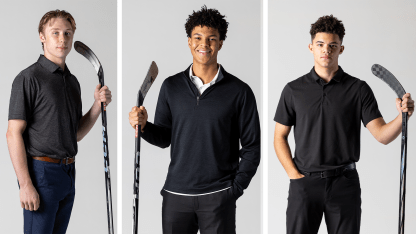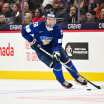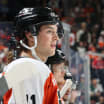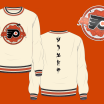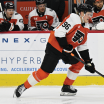It is no secret that the Flyers prospect pool is currently thinner at center than at any other position. It remains to be seen if the Flyers are able to select a natural center with the 12th overall pick in the first round of the 2024 Entry Draft. Arguably, there are only a smattering of centers in this year's Draft class who are likely to be rated within the top dozen to 15 Draft-eligible prospects.
The Flyers, as usual, have pledged to go strictly by their internal rankings of the 2024 Draft pool. If a defenseman or a winger is at the top by the time Philly makes their first pick, that's the player the Flyers will pick. If it's a center on top of the list, so much the better. However, the team will not dip down several spots to take a center over a higher-ranked blueliner or winger.
Boston University center Macklin Celebrini is almost certain to be selected by the San Jose Sharks with the first overall pick of the Draft. After that, the field opens to various centers or center/wing swingmen who could realistically fall within the first half of the opening round.
Here are four centers or center/wing candidates beyond Celebrini who could land in the top 12 picks.
Cayden Lindstrom (Medicine Hat Tigers, WHL)
Lindstrom fits to a tee the classic profile of an early first-round center. He's big (6-foot-3, 210 pounds). He's highly skilled (27 goals and 46 points in 32 games during the WHL regular season). Lindstrom's ceiling has been compared to Vancouver Canucks center J.T. Miller and other large-framed impact centers in the National Hockey League.
Lindstrom dealt with back and hand injuries this past season. As such, there were questions as to whether he might drop further at the Draft than a prospect with his traits would typically be selected (normally within the top five). That remains to be seen, but a lot of the injury concerns were potentially alleviated by Lindstrom's medical and physical testing at the 2024 Draft Combine in Buffalo. While anything can happen this Draft year, most pundits predict Lindstrom will be off the board well ahead of the 12th overall pick.
Konsta Helenius (Jukerit Mikkeli, Liiga)
Helenius is strictly of average height (generally listed at 5-foot-11) but he's sturdy physically and plays a very well-rounded and mature game. He is often rated among the most hockey-smart players -- at any position -- in this year's Draft class and is the rare player who tends to be more and more appreciated with repeated viewings by scouts rather than having flaws noticed and picked apart. Helenius, a right-handed shooter, is more surgical than spectacular but that is exactly the type of game than often translates best to the NHL. He's already having success against pros in Finland's top domestic league. Highly ambitious and competitive, Helenius can play wing in addition to center, but more likely will play in the middle because of his two-way game. Offensively, he's a highly skilled playmaker. His shooting skills have room for growth. Overall, he's considered both a high-floor AND a high-ceiling prospect even though he may not post superstar numbers.
There is often a tendency to compare prospects to countrymen who came before them. That can be limiting and unfair. However, one scout's comparison of Helenius was to longtime NHL center Saku Koivu -- highly intelligent and complete. Competitive even against bigger framed opponents, offensively productive year-in and year-out but not quite to an Art Ross Trophy contender level, and a dressing room leadership player -- shows how highly regarded this prospect is at age 18. Current Florida Panthers center Anton Lundell is another player to whom Helelius gets compared.
Next season, Helenius is slated to play for Tappara Tampere, his parent club in Liiga. However, he's widely considered to be close to being NHL ready.
Berkly Catton (Spokane Chiefs, WHL)
If Catton had Lindstrom's physical profile, he'd be a virtual slam-dunk candidate for top-five selection in this year's Draft. He's one of the one most dynamic offensive talents in the Draft as is coming off a 116-point season in his Draft-eligible season. Catton is a wizard with the puck on his stick and can both set up teammates and finish his own scoring chances at a very high level. Skating wise, he is outstanding on his edges and elusive. He is fine, but not elite, in a straight-ahead foot race. Added strength will be needed. Players of Catton's physical profile, even if they play center at the junior level, often end up as wingers in the NHL. There's nothing wrong with that, but centers tend to be valued a little bit higher.
In Catton's case the player's hockey sense and creativity could potentially make him one of the relatively few small-framed centers who stays there right up to the NHL level and continue to thrive offensively. It's not that he's pint-sized, but the 5-foot-10 prospect needs to add significant muscle and make various subtle adjustments to avoid getting overmatched by top NHL centers. He's not as physically mature as Helenius and he still has more adjustments from a junior's game to a pro's. However, his skill and smarts combination give Catton a high ceiling.
The defensive side of the game is no problem for Catton at the junior level -- and he has the puck far more often than not -- but he rarely faces opponents of comparable skill and attention to detail who are also significantly bigger and stronger. Protecting the puck and getting it back when you don't have possession is much easier against juniors than it is against upper-lineup pros. He'll need to attack through the middle because he's harder to dangle and bob and weave successfully in the NHL until there's a play to make.
Catton has the potential to navigate all of these challenges and become one of the exceptions as a highly successful as a smaller NHL center. Dallas Stars center Logan Stankoven, who is smaller than Catton, plays both center and right wing. and has thus far been successful. However, it also would not be surprising if Catton is eventually moved to a wing on a full-time basis as a pro. Either way, he has impact player upside.
Tij Iginla (Kelowna Rockets, WHL)
Yes, Iginla has a famous surname. He's the son of longtime NHL star Jarome Iginla. However, Tij Iginla's playing style is quite different from his physically dominating power winger dad. He competes and has a good head for the game, but the younger Iginla is not as equipped to run over or through an opponent and powering to the scoring areas.
Igina had an outstanding Under-18 World Championships tournament for Team Canada to cap off a year in which he posted 84 regular season points (64 games) and nine goals and 15 total playoff points (without taking a single penalty) in 11 games. He's widely considered to be a potential top-seven to top-10 pick this year and almost universally ranked in the upper half of the first round.
Iginla, currently listed at an even six feet tall and 185 pounds, may eventually play at 200 pounds as he continues to fill out. He played more wing than center this past season in the Western Hockey League but center was his original position and he aims to move back to the middle on closer to a full-time basis for the 2024-25 season. Positional versatility is positive, not a negative.
Other centers and swingmen who could find their way into the top half of the first round in this year's Draft: Sacha Boivert (USHL), Jett Luchanko (OHL), Michael Hage (USHL).

